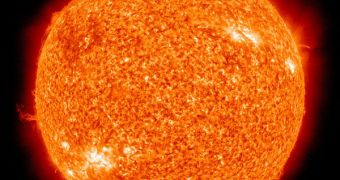Solar physicists have known that the Sun can flip its magnetic poles for quite some time. Over the years, they have kept track of these changes, and a team at NASA is now revealing how the entire process occurs in a brand-new visualization.
The Sun works in cycles that last 11 years, where periods of calmness, called solar minimums, alternate with periods of intense activity, called maximums. During each of these cycles, the star's magnetic poles switch places. On some occasions, the Sun took longer to make the switch, but this is a rare occurrence.
In the visualization above, negative magnetic fields are shown in magenta, while green lines indicate positive fields. The grey lines in the middle denote areas where magnetic variation occurs at certain times, as seen by a wide variety of telescopes aimed at the star.
A full magnetic solar cycle – where the negative pole does a full rotation around the Sun – therefore takes 22 years to complete. Usually, polar flips are associated with intense solar flares and sunspots, which can pose hazards to astronauts in low-Earth orbit, to satellites and to power grids here on Earth.

 14 DAY TRIAL //
14 DAY TRIAL //